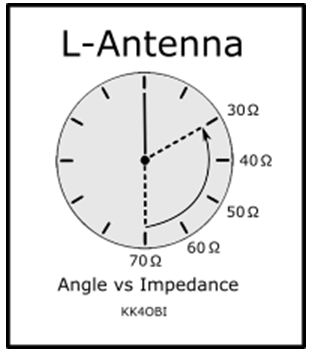

Antentop is FREE e-magazine devoted to Antennas and Amateur Radio an
Special page devoted to
The Three L-Antennas

Custom Search
|
ANTENTOP- 01- 2017, # 021 |
The Three L-Antennas |
||
|
The Three L-Antennas Wide- Equal - Tall |
|||
|
|
Dick Reid, KK4OBI |
||
|
A space saving antenna in the form of an upright
L has been around the amateur radio world for a long time. References
are found back to a QST article in the 60's (Reference
1), the ARRL Antenna Handbook in the 70's through 90's
(Reference 2)
and to L. B. Cebik's (References 3,4) and Craig LaBarge's (Reference 5) writings in recent years. Commercial
designs are seen in the Buddipole TM
(Reference
6), MFJ-1790 (Reference
7) and the CrankIR antennas
(Reference 8).
By the use of antenna modeling software (Reference 10), this article is to expand our general
knowledge relative to angle-of-bend and off-center-feed (OCF)
configurations of the L-Antenna. |
The L-antenna can be looked at as a center-fed dipole
bent in the middle or... a vertical monopole with a single radial.
At an elevation one-half wavelength a straight vertical dipole
has about 1.6 dBi gain (decibel isotropic). The L form however has gain
around 4 dBi in the direction where
the radial is pointing. Depending on ground conditions and mounting
height, the impedance is around 40 ohms making the configuration
a decent match for 50 ohm coaxial cable. Since the impedance of a vertical
dipole is around 70 ohms, there obviously is a 50 ohm point somewhere
between 0 degree down
and a bend of 90 degree horizontal... usually near 75 degree (or 15 degree below horizontal). Gain at this point is around
3 dBi. Interestingly, as the arm/radial
continues to be raised above horizontal, the impedance
declines to around 30 ohms, the Standing Wave Ratio (SWR) approaches
2:1 but the gain of the vertical monopole increases up to 5 dBi...
several times the gain of a vertical dipole. Off-Center-Feed (OCF) |
||
|
The L-Antenna
Figure
1 Angle Vs Impedance for L- Antenna |
|||
|
|
|
||
|
Page-12 |
|||
 |
 |
|
 |
Just for Fun:

Powered byIP2Location.com
Thanks for your time!
Last Updated:
January 4, 2020 12:55






